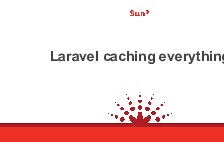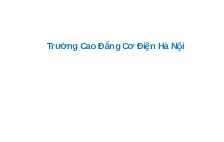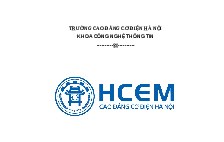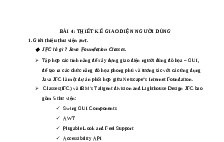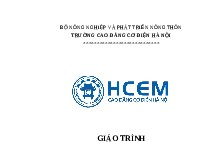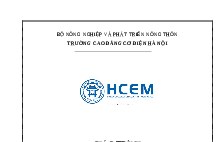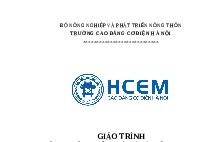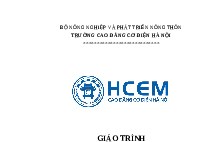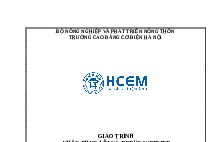SQLServerCh08
Nội dung tài liệu
Tải xuống
Link tài liệu:
Các tài liệu liên quan
Có thể bạn quan tâm
Thông tin tài liệu
Chapter 8
How to work
with data types
Book Title, C1
© 2012, Mike Murach & Associates, Inc.
Slide 1
Objectives
Applied
Code queries that use the data conversion functions to work with
the data types presented in this chapter.
Knowledge
Describe the data that can be stored in any of the string, numeric,
date/time, and large value data types.
Describe the difference between standard character data and
Unicode character data.
Describe the differences between implicit and explicit data type
conversion.
Book Title, C1
© 2012, Mike Murach & Associates, Inc.
Slide 2
SQL Server data type categories
String
Numeric
Temporal (date/time)
Other
Book Title, C1
© 2012, Mike Murach & Associates, Inc.
Slide 3
ANSI-standard data types
and SQL Server equivalents
Synonym for ANSI-standard
data type
binary varying
char varying
character
dec
double precision
float
integer
Book Title, C1
SQL Server data type used
varbinary
varchar
character varying
char
decimal
float
real or float
int
© 2012, Mike Murach & Associates, Inc.
Slide 4
ANSI-standard data types
and SQL Server equivalents (continued)
Synonym for ANSI-standard
data type
national char
national char varying
national text
rowversion
Book Title, C1
SQL Server data type used
nchar
national character
nvarchar
national character varying
ntext
timestamp
© 2012, Mike Murach & Associates, Inc.
Slide 5
The integer data types
Type
bigint
int
smallint
tinyint
bit
Book Title, C1
Bytes
8
4
2
1
1
© 2012, Mike Murach & Associates, Inc.
Slide 6
The decimal data types
Type
decimal[(p[,s])]
numeric[(p[,s])]
money 8
smallmoney
Book Title, C1
Bytes
5-17
5-17
4
© 2012, Mike Murach & Associates, Inc.
Slide 7
The real data types
Type
float[(n)]
real
Book Title, C1
Bytes
4 or 8
4
© 2012, Mike Murach & Associates, Inc.
Slide 8
Terms
Precision
Scale
Exact numeric data types
Floating-point number
Significant digits
Book Title, C1
© 2012, Mike Murach & Associates, Inc.
Slide 9
String data types for storing standard characters
Type
char[(n)]
varchar[(n)]
Bytes
n
String data types for storing Unicode characters
Type
nchar(n)
nvarchar(n)
Book Title, C1
Bytes
2×n
© 2012, Mike Murach & Associates, Inc.
Slide 10
Terms
Unicode characters
Fixed-length strings
Variable-length strings
Book Title, C1
© 2012, Mike Murach & Associates, Inc.
Slide 11
Date/time data types prior to SQL Server 2008
Type
datetime
smalldatetime
Bytes
8
4
Date/time data types for SQL Server 2008 and later
Type
date 3
time(n) 3-5
datetime2(n)
datetimeoffset(n)
Book Title, C1
Bytes
6-8
8-10
© 2012, Mike Murach & Associates, Inc.
Slide 12
Common date formats
Format
Example
yyyy-mm-dd
mm/dd/yyyy
mm-dd-yy
Month dd, yyyy
Mon dd, yy
dd Mon yy
2012-04-30
4/30/2012
4-30-12
April 30, 2012
Apr 30, 12
30 Apr 12
Common time formats
Format
Example
hh:mi 16:20
hh:mi am/pm
hh:mi:ss
hh:mi:ss:mmm
hh:mi:ss.nnnnnnn
4:20 pm
4:20:36
4:20:36:12
4:20:36.1234567
Book Title, C1
© 2012, Mike Murach & Associates, Inc.
Slide 13
How to use date/time literals
To code a date/time literal, enclose the date/time value in single
quotes.
If you don’t specify a time in a date/time value, the time defaults
to 12:00 a.m.
If you don’t specify a date in a date/time value, the date defaults
to January 1, 1900.
By default, the years 00 to 49 are interpreted as 2000 to 2049 and
the years 50 through 99 are interpreted as 1950 through 1999.
You can specify a time using either a 12-hour or a 24-hour clock.
For a 12-hour clock, am is the default.
Book Title, C1
© 2012, Mike Murach & Associates, Inc.
Slide 14
The large value data types
for SQL Server 2005 and later
varchar(max)
nvarchar(max)
varbinary(max)
How the large value data types map
to the old large object types
SQL Server 2005 and later
varchar(max)
nvarchar(max)
varbinary(max)
Book Title, C1
Prior to 2005
text
ntext
image
© 2012, Mike Murach & Associates, Inc.
Slide 15
Order of precedence for common data types
Precedence
Category
Data type
Highest
Date/time
datetime
smalldatetime
float
real
decimal
money
smallmoney
int
smallint
tinyint
bit
nvarchar
nchar
varchar
char
Numeric
String
Lowest
Book Title, C1
© 2012, Mike Murach & Associates, Inc.
Slide 16
Conversions that can’t be done implicitly
From data type
char, varchar, nchar, nvarchar
datetime, smalldatetime
money, smallmoney
To data type
money, smallmoney
decimal, numeric, float, real, bigint,
int, smallint, tinyint, money,
smallmoney, bit
char, varchar, nchar, nvarchar
Expressions that use implicit conversion
InvoiceTotal * .0775
-- InvoiceTotal (money) converted to decimal
PaymentTotal – 100
-- Numeric literal converted to money
PaymentDate = '2012-04-05'
-- Date literal converted to smalldatetime value
Book Title, C1
© 2012, Mike Murach & Associates, Inc.
Slide 17
Terms
Implicit conversion
Explicit conversion
Book Title, C1
© 2012, Mike Murach & Associates, Inc.
Slide 18
The syntax of the CAST function
CAST(expression AS data_type)
A SELECT statement that uses the CAST function
SELECT InvoiceDate, InvoiceTotal,
CAST(InvoiceDate AS varchar) AS varcharDate,
CAST(InvoiceTotal AS int) AS integerTotal,
CAST(InvoiceTotal AS varchar) AS varcharTotal
FROM Invoices;
Book Title, C1
© 2012, Mike Murach & Associates, Inc.
Slide 19
How to convert data when performing
integer division
Operation
Result
50/100
50/CAST(100 AS decimal(3))
0
.500000
Book Title, C1
© 2012, Mike Murach & Associates, Inc.
Slide 20
The syntax of the CONVERT function
CONVERT(data_type, expression [, style])
Convert and format dates
SELECT CONVERT(varchar, InvoiceDate) AS varcharDate,
CONVERT(varchar, InvoiceDate, 1) AS varcharDate_1,
CONVERT(varchar, InvoiceDate, 107) AS varcharDate_107,
CONVERT(varchar, InvoiceTotal) AS varcharTotal,
CONVERT(varchar, InvoiceTotal, 1) AS varcharTotal_1
FROM Invoices;
Book Title, C1
© 2012, Mike Murach & Associates, Inc.
Slide 21
Style codes for converting date/time data
to character data
Code
0 or 100 (default)
1 or 101
7 or 107
8 or 108
10 or 110
12 or 112
14 or 114
Book Title, C1
Output format
Mon dd yyyy hh:miAM/PM
mm/dd/yy or mm/dd/yyyy
Mon dd, yy or Mon dd, yyyy
hh:mi:ss
mm-dd-yy or mm-dd-yyyy
yymmdd or yyyymmdd
hh:mi:ss:mmm (24-hour clock)
© 2012, Mike Murach & Associates, Inc.
Slide 22
Style codes for converting real data
to character data
Code
0 (default)
1
2
Book Title, C1
Output
6 digits maximum
8 digits; must use scientific notation
16 digits; must use scientific notation
© 2012, Mike Murach & Associates, Inc.
Slide 23
Style codes for converting money data
to character data
Code
0 (default)
1
2
Book Title, C1
Output
2 digits to the right of the decimal
point; no commas to the left
2 digits to the right of the decimal
point; commas to the left
4 digits to the right of the decimal
point; no commas to the left
© 2012, Mike Murach & Associates, Inc.
Slide 24
The syntax of the TRY_CONVERT function
TRY_CONVERT(data_type, expression [, style ])
Convert and format dates
SELECT TRY_CONVERT(varchar, InvoiceDate) AS varcharDate,
TRY_CONVERT(varchar, InvoiceDate, 1) AS varcharDate_1,
TRY_CONVERT(varchar, InvoiceDate, 107)
AS varcharDate_107,
TRY_CONVERT(varchar, InvoiceTotal) AS varcharTotal,
TRY_CONVERT(varchar, InvoiceTotal, 1)
AS varcharTotal_1,
TRY_CONVERT(date, 'Feb 29 2011') AS invalidDate
FROM Invoices;
Book Title, C1
© 2012, Mike Murach & Associates, Inc.
Slide 25
Other data conversion functions
STR(float[,length[,decimal]])
CHAR(integer)
ASCII(string)
NCHAR(integer)
UNICODE(string)
Book Title, C1
© 2012, Mike Murach & Associates, Inc.
Slide 26
Examples that use the data conversion functions
Function
Result
STR(1234.5678, 7, 1)
CHAR(79)
ASCII('Orange')
NCHAR(332)
UNICODE(N'Or')
1234.6
O
79
O
332
Book Title, C1
© 2012, Mike Murach & Associates, Inc.
Slide 27
ASCII codes for common control characters
Control character
Tab
Line feed
Carriage return
Value
Char(9)
Char(10)
Char(13)
Use the CHAR function to format output
SELECT VendorName + CHAR(13) + CHAR(10)
+ VendorAddress1 + CHAR(13) + CHAR(10)
+ VendorCity + ', ' + VendorState + ' ' +
VendorZipCode
FROM Vendors
WHERE VendorID = 1;
US Postal Service
Attn: Supt. Window Services
Madison, WI 53707
Book Title, C1
© 2012, Mike Murach & Associates, Inc.
Slide 28


